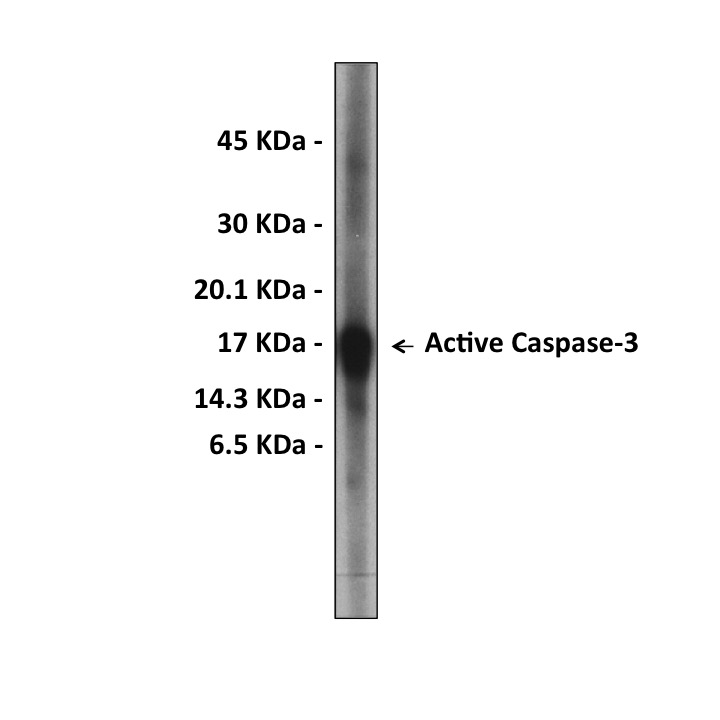Product Sheet CG1064
Description
BACKGROUND Caspases, short for cysteinyl aspartate proteases, are involved in the signal transduction pathways of apoptosis, necrosis and inflammation. These enzymes can be divided into two major classes: initiators and effectors. The initiator isoforms (caspases-1,-4,-5,-8,-9,-10,-11,-12) are activated by, and interact with, upstream adaptor molecules through protein-protein interaction domains known as CARD and DED. Effector caspases (-3,-6,-7) are responsible for cleaving downstream substrates and are sometimes referred to as the executioner caspases. More than 400 caspase substrates have so far been identified. Initiator caspases, such as caspase 8, may be directly activated by death receptors such as FasR. Caspases can also be found intracellularly as part of large multiprotein complexes. For example, caspase 9 is recruited to the apoptosome formed during apoptosis, whilst caspases-1 and 5 can form part of the inflammasome, a key part of cytokine processing during inflammation. Caspases are regulated by inhibitors of apoptosis and by dominant negative isoforms. They have been implicated in the pathogenesis of many disorders including stroke, Alzheimer\'s disease, myocardial infarction, cancer, and inflammatory disease.1
Caspases exist as inactive proenzymes which undergo proteolytic processing at conserved aspartic residues to produce two subunits, large and small, that dimerize to form the active enzyme. Sequential activation of caspases plays a central role in the execution-phase of cell apoptosis. Caspase-3 is a cytosolic protein found in cells as an inactive 32 kDa proenzyme. Activation of caspase-3 requires proteolytic processing of its inactive zymogen into activated p17 and p12 fragments. Cleavage of caspase-3 requires aspartic acid at the P1 position.2 Caspase-3 is processed by caspase-8, -9, and -10. Activated Caspase-3 cleaves and activates caspase- 6, -7 and -9. It is the predominant caspase involved in the cleavage of amyloid-beta 4A precursor protein, which is associated with neuronal death in Alzheimer\'s disease. It also cleaves poly(ADP-ribose) polymerase (PARP) at a \'216-Asp- -Gly-217\' bond at the onset of apoptosis.3
REFERENCES
1. Riedl, S.J. & Shi, Y. : Nature Rev. Mol. Cell Biol. 5:897-907, 2004
2. Nickolson, D.W. et al: Nature 367:37-43, 1995
3. Porter, A.J. & Janicke, R.U.: Cell Death Diff. 6:99-104, 1999
2. Nickolson, D.W. et al: Nature 367:37-43, 1995
3. Porter, A.J. & Janicke, R.U.: Cell Death Diff. 6:99-104, 1999
Products are for research use only. They are not intended for human, animal, or diagnostic applications.
Details
Cat.No.: | CG1064 |
Antigen: | Synthetic peptide corresponding to the cleavage site of human caspase 3 (amino acids 167-175) conjugated to KLH. |
Isotype: | Rabbit IgG |
Species & predicted species cross- reactivity ( ): | Human, Mouse, Rat, Canine, Pig, Bovine |
Applications & Suggested starting dilutions:* | WB 1:500-1:1000 IP n/d IHC n/d ICC n/d FACS n/d |
Predicted Molecular Weight of protein: | 32 KDa |
Specificity/Sensitivity: | Detects endogenous Caspase-3 proteins without cross-reactivity with other family members. |
Storage: | Store at -20°C, 4°C for frequent use. Avoid repeated freeze-thaw cycles. |
*Optimal working dilutions must be determined by end user.
Products
| Product | Size | CAT.# | Price | Quantity |
|---|---|---|---|---|
| Polyclonal Active Caspase-3 Antibody: Polyclonal Active Caspase-3 Antibody | Size: 100 ul | CAT.#: CG1064 | Price: $384.00 |

